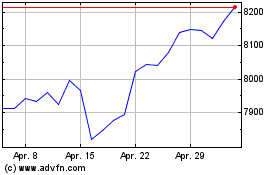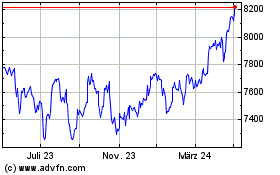By Chris Matthews and Mark DeCambre, MarketWatch
The ISM manufacturing index showed the slowest pace of expansion
in more than two years.
U.S. stocks rose Friday, though well off session highs, with
early action colored by news that trade negotiations between
Beijing and Washington may conclude as soon as two weeks, while new
data on U.S. manufacturing disappointed, causing markets to pare
early-morning gains.
How are benchmarks faring?
The Dow Jones Industrial Average gained 43 points, or 0.2%, to
reach 25,952, while the S&P 500 index gained 8 points to 2,792,
a rise of 0.3%. The Nasdaq Composite Index advanced 25 points, or
0.3%, to 7,558.
At session highs early Friday morning, the Dow had risen as much
as 228 points, the S&P 500 rose 24 points, and the Nasdaq
rallied as much as 60 points higher.
What's driving the market?
Market participants pointed to fresh hope of a conclusion to
Sino-American trade negotiations in the coming week or two as among
the factors likely supporting buying.
According to Bloomberg News
(https://www.bloomberg.com/news/articles/2019-02-28/u-s-said-to-ready-final-china-trade-deal-as-hawks-urge-caution?srnd=premium-asia),
U.S. officials were preparing for a summit between President Donald
Trump and Chinese leader Xi Jinping, at which a 150-page agreement
could be signed. However, during a news conference while abroad
this week, the president emphasized his willingness to walk away if
a favorable trade deal couldn't be struck.
On Wednesday, top trade negotiator Robert Lighthizer said that
tariffs on $200 billion in Chinese goods set to increase to $25%
from 10% at 12:01 a.m. March 2, wouldn't go into effect.
Meanwhile, in the U.K., the opposition Labour Party has
confirmed it would support a second referendum on membership of the
European Union, while Prime Minister Theresa May has agreed to
allow Parliament to delay Brexit, which many analysts say raises
the chances that the nation's withdrawal from the bloc will be put
off past the March deadline.
On Thursday, data on U.S. gross domestic product showed that
growth slowed to a pace of 2.6% in the fourth quarter. However,
that figure was better than 1.9% expected by economists polled by
MarketWatch economists. Investors have been debating the merits of
the hotter-than-expected number against the backdrop of a trend of
falling GDP from its mid-2018 peak at 4.2%.
What did the data show?
The Commerce Department reported that the PCE inflation index
rose 0.1% in December, compared with the 0.4% increase in November,
above economists estimates of a 0.4% decline, according to a
MarketWatch poll. The 12-month change in prices remained steady at
1.9%.
It also said that consumer spending fell 0.5% in December, the
largest amount since 2009
(http://www.marketwatch.com/story/consumer-spending-falls-off-a-cliff-in-december-posts-biggest-drop-since-2009-2019-03-01).
Meanwhile, the government reported that personal income rose 1%
in December, above economists expectations of 0.4%, and above the
0.2% rise in November.
The Institute for Supply Management's manufacturing index fell
to 54.2% in February
(http://www.marketwatch.com/story/manufacturers-grow-at-slowest-pace-since-trumps-election-in-fall-2016-ism-finds-2019-03-01),
below economists expectations of 55.5%, according to a MarketWatch
poll of economists. It also marked the slowest pace of growth since
the election of President Trump in November 2016
Markit's manufacturing PMI also disappointed, coming in at 53.0
in February, after hitting 53.7 in January.
Consumer sentiment came in below economists' expectations
(http://www.marketwatch.com/story/university-of-michigan-consumer-sentiment-reading-misses-expectation-2019-03-01),
with the University of Michigan's index came in at 93.8, versus
expectations of 95.6, per a MarketWatch survey of economists.
What are strategists saying?
"Both of the US manufacturing PMIs dramatically undershot
expectations," Connor Campbell, financial analyst with SpreadEx
wrote in a Friday note. "Granted, these numbers are a lot better
than what was posted by the UK, China and the Eurozone -- the
latter 2 regions saw their respective manufacturing sectors stuck
in contraction territory -- earlier in the day, but they are
nevertheless cause for concern," he added.
It was these disappointing figures that helped put pressure on
stocks Friday morning, causing them to fall "well off the 170 point
rise suggested by the futures before the PMIs were released," he
wrote.
Which stocks are in focus?
Shares of Gap Inc. (GPS) were in focus after the giant clothing
retailer said late-Thursday that it was splitting into two publicly
trade companies and closing some 200 stores. The stock surged 18.6%
Friday.
Foot Locker Inc. shares(FL)were in focus Friday
(http://www.marketwatch.com/story/foot-locker-shares-soar-185-premarket-after-blowout-earnings-2019-03-01),
after the sporting goods and apparel retailer blew past earnings
estimates for its fiscal fourth quarter. The stock rose 6.1% Friday
morning.
Shares of Immunogen Inc. (IMGN) are under pressure Friday, after
the company said a phase 3 trial of its ovarian cancer treatment,
mirvetuximab soravtansine, compared with chemotherapy, failed to
meet its primary endpoint
(http://www.marketwatch.com/story/immunogens-stock-loses-nearly-half-its-value-after-trial-of-cancer-treatment-fails-to-meet-primary-endpoint-2019-03-01)
of progression free survival. The sock fell 48.7% Friday.
Shares of Tesla Inc. (TSLA) fell 7.4% early Friday, after the
electric-car manufacturer announced
(http://www.marketwatch.com/story/tesla-launches-35000-shorter-range-model-3-2019-02-28)
Thursday evening that it is likely to report a loss in the fourth
quarter, contrary to previous predictions. Tesla also announced
that it would offer its Model 3 for $35,000 dollars, while saying
it would layoff employees to cut costs.
Dentsply Sirona Inc. (XRAY) stock surged 14.9% Friday, after the
maker of dental products and technologies beat analyst estimates
(http://www.marketwatch.com/story/dentsply-sirona-earnings-top-estimates-2019-03-01)
for fourth-quarter earnings and sales.
Shares of Walgreens Boots Alliance Inc. (WBA) fell 4% Friday,
after the drugstore chain said
(http://www.marketwatch.com/story/walgreens-stock-sinks-to-lead-dow-losers-as-reimbursement-headwinds-generic-deflation-pressures-continue-2019-03-01)
it continues to face reimbursement headwinds, as well as pressure
from falling prices for generic drugs.
How did stocks trade yesterday?
On Thursday
(http://www.marketwatch.com/story/dow-sp-500-set-for-3-day-skid-as-wall-street-awaits-fourth-quarter-gdp-2019-02-28),
the Dow fell 69.16 points, or 0.3%, to 25,916; the S&P 500
index shed 7.89 points, or 0.3%, to 2,784.49; and the Nasdaq
Composite Index declined 21.98 points, or 0.3%, to 7,532.53.
All indexes rose for a second month in a row, with the Dow
rallying 3.7% in February, the S&P 500 up 3% and the Nasdaq
gaining 3.4%.
What's happening in other markets?
Stocks in Asia rose Friday on trade optimism; Japan's Nikkei 225
, Hong Kong's Hang Seng Index , and China's Shanghai Composite
Index all closed higher.
In Europe, stocks closed, with the Stoxx Europe 600 rising in
Friday trade, buoyed by German stocks, where the Dax (DAX) was
rising 0.9%.
In commodities markets, the price of oil was edging lower, while
gold prices were retreating. The U.S. dollar rose 0.1%.
(END) Dow Jones Newswires
March 01, 2019 11:29 ET (16:29 GMT)
Copyright (c) 2019 Dow Jones & Company, Inc.
FTSE 100
Index Chart
Von Mär 2024 bis Apr 2024

FTSE 100
Index Chart
Von Apr 2023 bis Apr 2024
